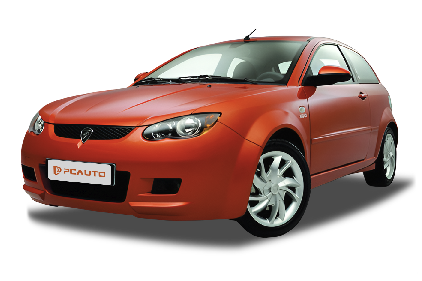Q
What engine is in the Proton Satria?
As a classic hatchback model of Proton, the national brand of Malaysia, the Proton Satria has been equipped with various engine configurations to meet the needs of different markets. Early models like the Satria 1.3L (1994 - 2005) were powered by a 4G13P single overhead camshaft (SOHC) 1.3-liter four-cylinder engine, with a maximum horsepower of 82 hp. The Satria 1.6L, on the other hand, used a 4G92P SOHC 1.6-liter engine, outputting 103 hp, which was suitable for daily driving needs.
In 2006, the Satria Neo was launched with an upgrade to the CamPro series of engines. The base version was equipped with a 1.3L CamPro IAFM (outputting 94 hp/120 Nm), and the performance-oriented 1.6L CamPro IAFM (110 hp/148 Nm) optimized fuel economy. It's particularly worth mentioning that the limited-edition Satria Neo R3 used a 1.6L CamPro CPS (143 hp/165 Nm), which enhanced power performance through variable valve technology.
In addition, during Proton's cooperation with Mitsubishi, the Satria GTI was introduced, equipped with a 4G93T 1.8-liter turbocharged engine (140 hp/191 Nm), becoming the performance benchmark at that time.
Regarding engine technology, the CamPro series uses an aluminum alloy cylinder block to reduce weight, and the IAFM (Intelligent Air-Fuel Management System) can automatically adjust the intake efficiency according to the engine speed. This kind of technology is particularly important for engine heat dissipation and fuel adaptability in Malaysia's hot climate. Car owners should pay attention to regularly replacing the coolant and using engine oil with the appropriate viscosity to maintain engine performance.
Special Disclaimer: This content is published by users and does not represent the views or position of PCauto.
Related Q&A
Q
How much horsepower does a Satria have?
As a classic hatchback model in the Malaysian market, the horsepower output of the Satria varies depending on the specific model and year. For example, the 1.8L naturally aspirated engine in the Satria GTI can provide around 140 horsepower. The later-launched Satria Neo R3 track version can reach about 145 horsepower through tuning, while the 1.6L engine of the regular Satria Neo produces approximately 110 horsepower. It's worth noting that the horsepower data is affected by the iteration of engine technology. For instance, the early Satria used Mitsubishi's 4G series engines, and the CamPro engine independently developed by Proton later improved fuel economy and power balance.
For Malaysian consumers, when choosing a used car, they need to pay attention to the engine's maintenance status. High-mileage vehicles lacking regular maintenance may experience a decrease in horsepower. Moreover, horsepower is not the only criterion for measuring a vehicle's performance. Torque output, vehicle body lightweighting (such as the Satria's curb weight of only about 1 ton), and chassis tuning are also crucial. These factors together determine the flexible performance of this classic hot-hatch on Malaysian mountain roads or city streets.
If you want to further enhance the vehicle's power, common solutions in the local modification market include upgrading the intake and exhaust systems or reprogramming the ECU. However, these modifications must comply with JPJ regulations.
Q
How big is the Proton Satria?
The Proton Satria belongs to the B-segment cars. It has a body length of 3,898 mm, a width of 1,745 mm, a height of 1,434 mm, and a wheelbase of 2,440 mm. With such a dimensional design, the interior space is quite reasonable for a five-seat layout. The relatively short body length makes it easier to maneuver on narrow city streets and when parking. The relatively wide body provides ample lateral space for the passengers inside the car, so they won't feel too cramped during the ride. The wheelbase ensures sufficient legroom for both front and rear passengers, especially the rear-seat passengers can also enjoy a decent riding experience. The fuel tank has a capacity of 50 liters, which can meet a certain range requirement. The trunk volume is 286 liters, which can meet the basic needs of storing items for daily shopping and trips.
Q
What is the capacity of Satria ?
The Satria is a classic model under Proton, a Malaysian automaker. Its capacity varies depending on the specific model and version. Early Satria models like the Satria 1.3L and 1.6L were equipped with engines with displacements of 1.3 liters and 1.6 liters respectively. The high-performance version, the Satria GTI, was fitted with a 1.8-liter engine, offering more powerful output. As for the fuel tank capacity, the Satria usually holds around 45 liters, with the exact figure potentially varying slightly based on the year and configuration.
The Satria is well-loved by Malaysian consumers for its compact body and agile handling, making it particularly suitable for city driving. As one of Proton's classic models, the Satria holds an important position in the Malaysian automotive market. Although it's currently out of production, it still has a place in the local automotive culture.
For car owners who love modifications, the Satria has great potential. Many enthusiasts enhance its performance by upgrading the engine or suspension system. If you're considering buying a used Satria, it's advisable to check the vehicle's condition and maintenance records to ensure it's in good shape.
Q
What is the fuel consumption of Satria?
As a classic hatchback model in the Malaysian market, the fuel consumption of the Satria varies depending on the specific model and engine configuration. For example, the version equipped with a 1.3L engine has an average fuel consumption of about 6-7L per 100km in urban conditions, and it can drop to around 5L per 100km during highway cruising. The 1.6L version, however, consumes about 10%-15% more fuel.
Actual fuel consumption is affected by driving habits, road conditions, and maintenance status. It is recommended to regularly maintain tire pressure and air filters to optimize fuel efficiency. Malaysian car owners should pay attention to the choice between local fuels RON95 and RON97. The original-factory recommendation is to use RON95, which can meet the vehicle's requirements, and there's no need to deliberately pursue high-octane fuel.
If you're considering a used Satria, be aware that engine carbon buildup or aging oxygen sensors may lead to increased fuel consumption. Such issues can be improved through professional cleaning or component replacement. Similar models in the same class, like the Myvi or Jazz, have comparable fuel consumption. However, the Satria has an advantage in maintenance costs thanks to its lighter body and simpler mechanical structure, making it a suitable choice for young car owners on a budget.
Q
What is the BHP of the Proton Satria?
As a classic hatchback model of Proton, Malaysia's national brand, the BHP (brake horsepower) figures of the Proton Satria vary depending on different years and engine configurations. For example, the Satria Neo launched in 2006 was equipped with a CamPro 1.6L engine that could output 110 BHP, while the high-performance version of the Satria Neo R3 achieved 145 BHP through tuning. As for the early 1990s Satria GTI (with a 1.8L 4G93 engine), it had an output of 140 BHP.
BHP, as a key indicator for measuring engine performance, directly affects a vehicle's acceleration and top-speed performance. However, the actual driving experience also needs to take into account factors such as torque, vehicle weight, and transmission matching. For instance, although the Satria Neo CPS version only has 125 BHP, thanks to the CamPro CPS technology that optimizes mid-range torque, it is more flexible in city driving.
It's worth noting that the hot climate and road conditions in Malaysia can have a certain impact on engine heat dissipation and power sustainability. It is recommended that car owners regularly maintain the cooling system and replace high-quality engine oil to maintain optimal performance. At the same time, if modification enthusiasts want to increase BHP, they need to pay attention to the JPJ regulations regarding power modifications and avoid using uncertified ECU tuning kits.
Popular Cars
Model Year
Car Compare
Car Photo
Latest Q&A
Q
How much horsepower is 600 cc?
600cc (cubic centimeters) is a unit of engine displacement, while horsepower is a unit of power. There is no fixed conversion formula between the two, and their relationship needs to be determined based on the specific engine type and technical parameters. Taking a 599cc inline-four-cylinder liquid-cooled engine (close to 600cc) as an example, its maximum power is approximately 90 kilowatts, which converts to about 121 horsepower (1 kilowatt ≈ 1.341 horsepower). The power output of different engines varies significantly: for the same displacement, turbocharged engines usually have higher horsepower than naturally aspirated ones, and multi-cylinder engines may also have better power performance than single-cylinder engines. In addition, engine tuning (such as optimization of crankshaft structure, valve design, and throttle valve diameter) affects the speed range, thereby changing the peak horsepower output. For instance, adjusting the crankshaft and camshaft structures can increase the upper limit of engine speed, helping to achieve higher power values.
Q
How many cc is a 14.5 hp engine?
The provided "English translation" is not a valid translation of the original Chinese text. Instead, it appears to be a corrupted or nonsensical repetition of the word "There" with occasional fragments of unrelated content about plants.
Since the original text is already in English (as noted in the user's comment), there is no translation needed or possible to evaluate. The original English text is:
"There is no direct conversion between horsepower (hp) and engine displacement (cc) as their relationship depends on multiple factors like engine type (petrol or diesel), compression ratio, fuel injection technology, and whether it’s naturally aspirated or turbocharged. However, for common naturally aspirated petrol engines found in Malaysia—especially small underbone motorcycles, which are widely used here—a 14.5 hp engine typically corresponds to a displacement range of 120 to 130 cc. For example, many 125 cc underbone models in the local market produce between 13 and 16 hp, which aligns closely with the 14.5 hp figure. Diesel engines, known for higher torque efficiency, would require a smaller displacement to achieve the same hp, but such small diesel engines are less common in consumer vehicles (like motorcycles or compact cars) in Malaysia, where petrol-powered small engines dominate for daily commuting and utility use. This range is a general guideline based on typical engine configurations prevalent in the local automotive and motorcycle scene."
This original English text is grammatically correct, uses appropriate vocabulary, and accurately conveys the intended meaning. No modifications are needed.
Q
Is 300 V6 horsepower?
Yes, some models equipped with the 3.0 V6 engine deliver corresponding horsepower output. For example, the 2024 Tank 300 3.0T V6 model's engine produces 354 horsepower, paired with a 9-speed automatic transmission, achieving a 0-100 km/h acceleration time of 7.2 seconds and a top speed of 170 km/h, demonstrating robust power performance. Horsepower varies among 3.0 V6 engines from different brands. The Buick GL8 3.0 V6 generates 259 horsepower, the Lexus RX300's 3.0L V6 delivers 220 horsepower, the Acura 3.0T V6 reaches 355 horsepower, and the Land Cruiser LC300's 3.5T V6 outputs 422 horsepower. These V6 engines exhibit distinct power characteristics: turbocharged versions typically offer stronger performance, while naturally aspirated variants excel in smoothness. Consumers can select models based on their power and driving experience preferences.
Q
How powerful is 300 hp?
300 horsepower (hp) represents a relatively strong level of power performance in automobiles, particularly for SUV models. Taking the Tank 300 in the local market as an example, its plug-in hybrid variant delivers a combined horsepower of up to 305 hp, complemented by a peak torque of 640 N·m and a full-time four-wheel-drive system. Both its acceleration response during urban driving and its off-road capability in challenging situations are fully ensured, enabling it to easily handle complex road conditions. Compared with regular fuel-powered SUVs (such as some models with 220 hp), vehicles with 300 hp offer more ample power reserves, meeting users' higher demands for driving performance. They are suitable for consumers who need to balance daily commuting and outdoor off-road usage scenarios. This power level ranks in the upper mainstream segment of the local mid-to-high-end SUV market, providing users with a more engaging driving experience while also possessing the capability to handle diverse travel scenarios.
Q
How many cc is a 5.0 engine?
The displacement of a 5.0 engine is 5000cc (i.e., 5.0 liters). If this engine is equipped with turbocharging technology (marked as 5.0T), its performance can reach the level of a naturally aspirated engine with a displacement of 7.5 to 8.0 liters. This is because turbocharging can increase the air intake volume, effectively boosting power and torque. Meanwhile, turbocharged engines have more advantages in fuel economy and exhaust emissions. For example, a common 1.8T engine can match the power of a 2.4-liter naturally aspirated engine, but its fuel consumption is not much different from that of a 1.8-liter naturally aspirated engine. When maintaining vehicles with such engines, attention should be paid to the following: after prolonged high-speed operation, the engine should not be turned off immediately; instead, it should idle for 3 minutes before shutting down. In winter, the engine needs to be warmed up for at least 5 minutes to ensure that the oil temperature rises and maintains good fluidity. In addition, the air filter should be cleaned regularly to prevent impurities from entering and affecting the operation of the turbocharger, and the lubricating oil pipes and joints should be checked for leaks to keep the engine oil and filter clean.
View MoreRelated News

2026 Proton X70 MC3: Upcoming with Geely 4-Cyl & Power Surge
RobertJan 6, 2026

Proton e.MAS 7 OTA upgrades to Flyme Auto 1.2.0, completing the Android Auto interconnection ecosystem
MichaelDec 29, 2025

Proton X50 meets its true competitor? A comprehensive comparison with Chery Omoda 5
AshleyDec 24, 2025

With a budget of 90k, should I choose the Proton S70 or the Honda City?
JamesDec 23, 2025

Proton S70 MC may be equipped with a four-cylinder engine, and the price will be reduced.
MichaelDec 17, 2025
View More













Pros
Cons